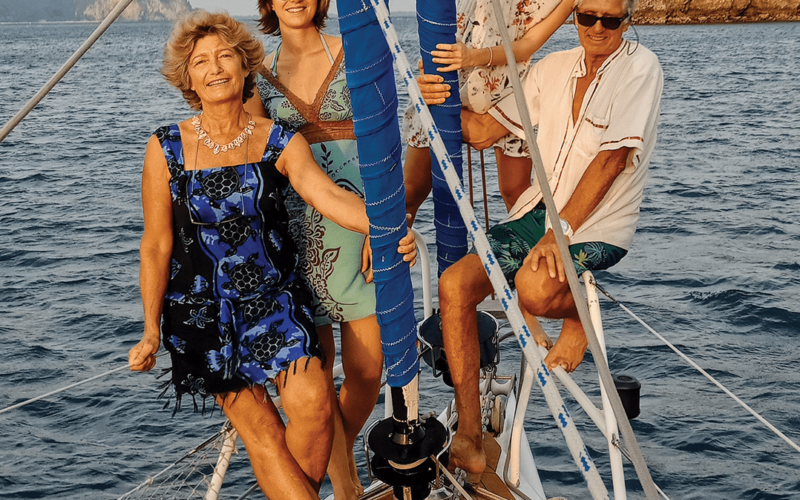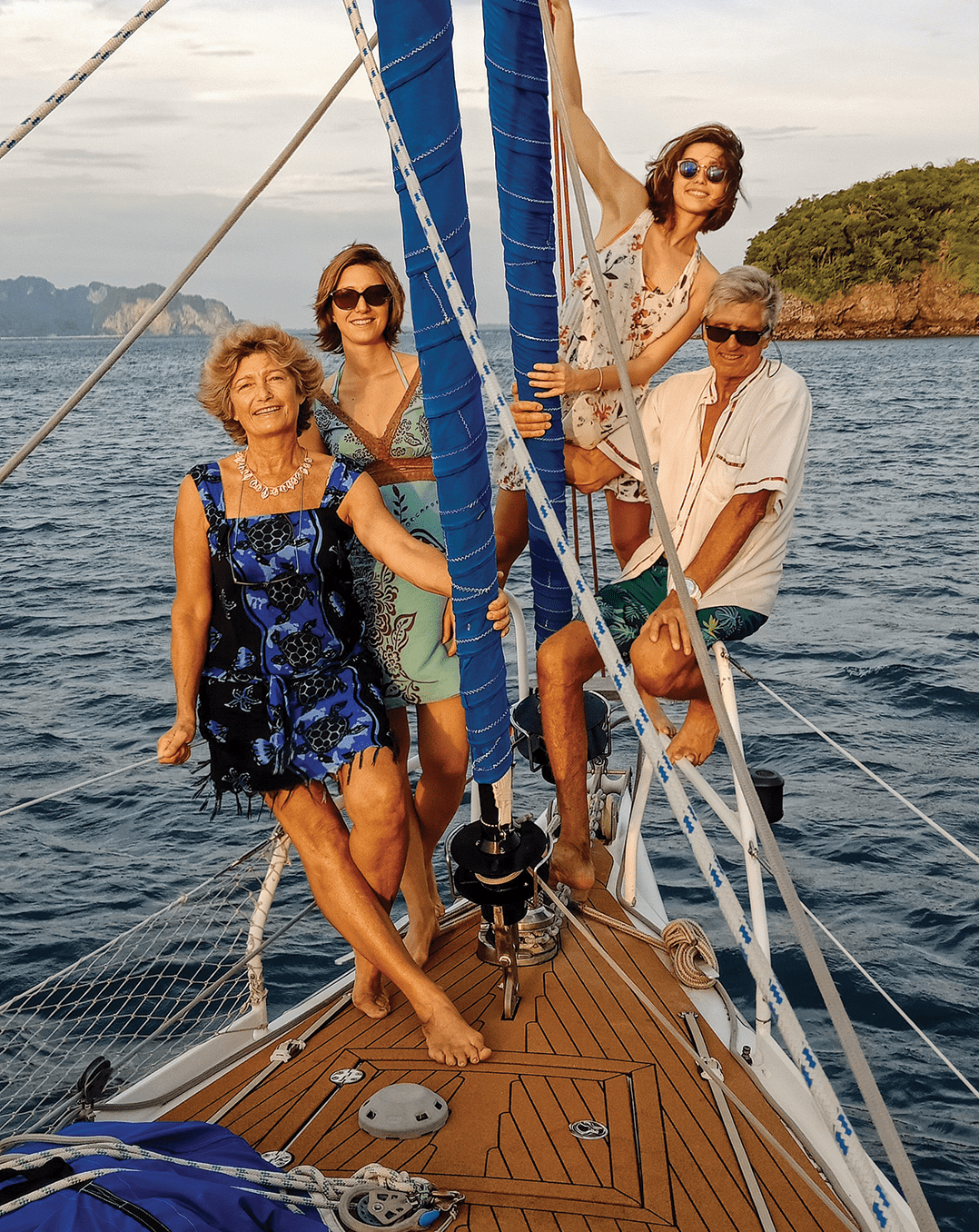
Corinne Gau-Tchekov and Michel Gau voyage aboard their Alliage 49 aluminum monohull, Ganesh. They left France in 2011 after Michel’s retirement and have been sailing around the world on a six-month-at-sea/six-month-on-land rhythm, leaving Ganesh in various boatyards along the way. Having crossed the Atlantic and Pacific oceans, then cruised for six years in Southeast Asia, they are currently in Malaysia, almost ready to cross the Indian Ocean.
Corinne and Michel have been married for 37 years, and they started sailing in 1987, just after the birth of their first daughter, Marina. In 1990, they took a sabbatical year on their first Ganesh, a 39-foot Beneteau, which enabled them to discover the Mediterranean Sea, cross the Atlantic Ocean for the first time and then cruise in the West Indies. Their second daughter, Alizée (French for “tradewind”), came into the world in 1991. In 1995, the whole family started a seven-year sabbatical circumnavigation on a second Ganesh, a Passoa 47 aluminum centerboard boat from a renowned Garcia boatyard. They closed the big loop in 2002, sold the boat, bought a house in the South of France and went back to work.
However, the sailing virus urged them to “go down to the sea again,” and in 2009, they started to build their third Ganesh, another aluminum centerboard boat, with a hull designed by the famous naval architect Berret-Racoupeau, but fully customized by Alliage boatyard in Brittany.
Michel is an engineer, having graduated in 1973 from Ecole Nationale des Arts et Métiers, and has worked as a sales and general manager in various IT and engineering companies. In 1995, he received his HAM radio license (F4FXX). In 2003, after his first circumnavigation, he succeeded in securing his professional sailing captain’s license (“Brevet Patron Plaisance Voile”).
Corinne graduated from HEC Paris, a major business school, in 1981 and has been working as an IT and HR project manager in banking and catering. She received her French cruising license in 1994. Before sailing, Corinne and Michel loved travelling on land and were fans of windsurfing. They also completed a diving certification program in French Polynesia and now dive frequently.
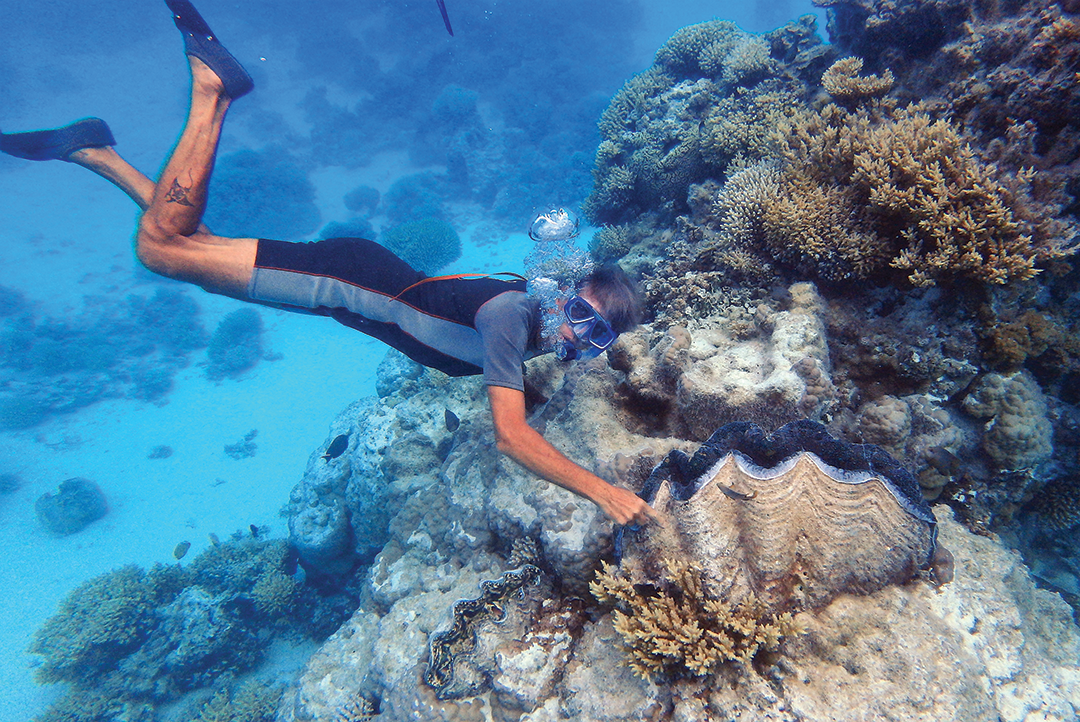
OV:
What inspired you to go voyaging?
C&MG:
We have always been travelers keen on discovering new cultures, new landscapes, new people and languages. We always try to learn some basic words in each new country we visit. It is the best passport to meeting people.
In the 1980s, we were land travelers for at least three to four weeks every year in a new remote country. In 1985, a trip to North India changed our philosophy of life. Voyaging became a way of learning and living, and a sailboat appeared to us as the best solution to discover the world at our own rhythm, especially with young children. We then had to learn how to sail, which we did together in 1987 on two training ships, and then we bought our first sailboat!
The story of Ganesh, the popular Indian god with an elephant head, the god of wisdom, education and luck, remover of obstacles, protector of family and travelers, inspired us, and we gave the name Ganesh to our three successive sailboats. We are still grateful for his protection and karma.
As long as we enjoy discovering new countries and new people, we’ll try to follow this way of life, health permitting, although we also want to keep a balance among sea life, land life and family life with our children and grandchildren.
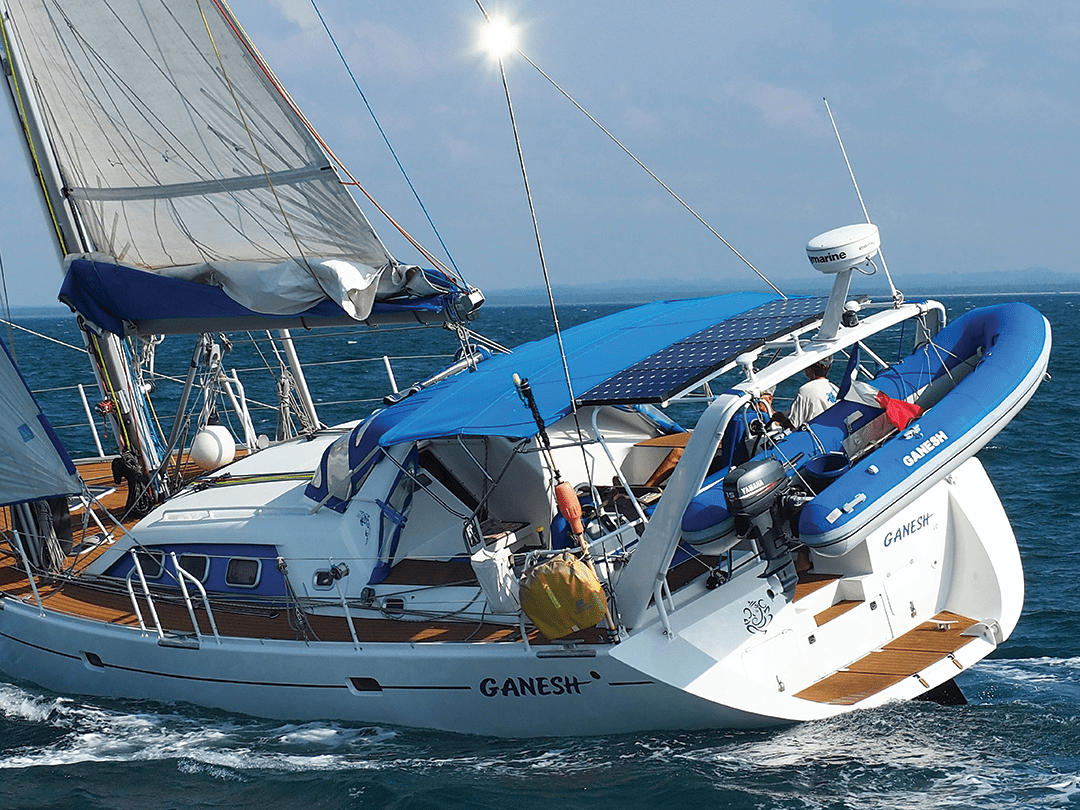
OV:
What is it about your boat that prompted you to choose it?
C&MG:
Our former Garcia Passoa 47 and now our Alliage 49 share many features in common, which are, according to our 30-year sailing experience, key features for a safe, comfortable and pleasant voyage.
First, their hulls are built of solid aluminum. When you see the damage caused by a bump against rocks or coral, or by a collision with a whale or a drifting container, or an accidental fall from a hardstand during a hurricane, or by a collision with another boat, you feel happy to have chosen aluminum! A dent is always better than a hole.
Next is the center board design. When your draught is less than 1.2 meters, you have the pleasure and confidence to access protected anchorages and shallow passages through islands, atolls and rivers. And when we need to sail into a headwind, we just drop the center board down. With 3.2-meter draught, we can sail with a correct 40-degree angle into the wind.
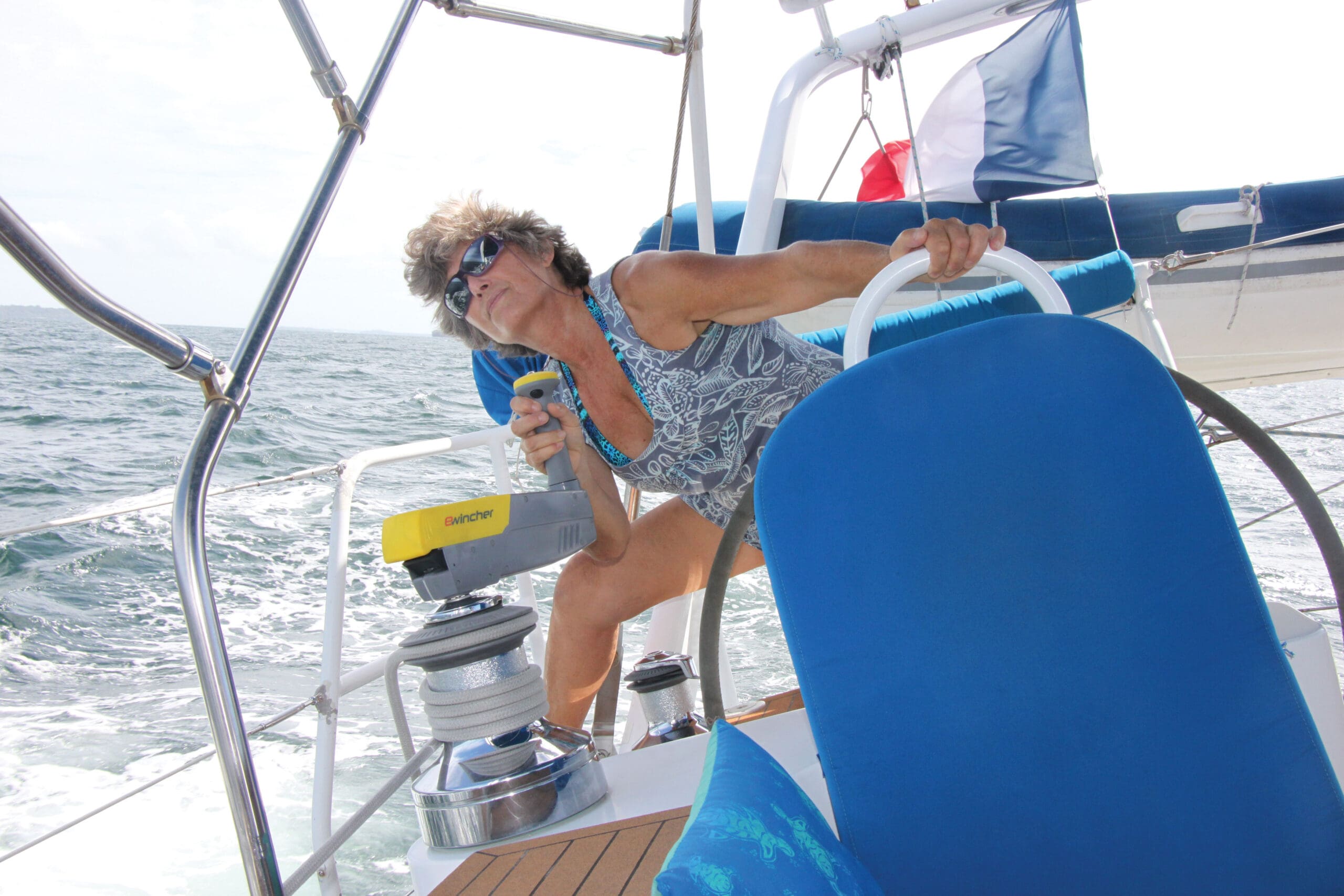
When we sail downwind, we lift the center board and our sailboat becomes a big surfboard on the waves, maintaining a stable and comfortable route with its two rudders. Last, but not least, it is fun to beach the flat bottom of the boat on sand at low tide for a quick hull cleaning and to collect shells!
As for customization to our needs and goals, our hulls have been designed by well-known naval architects: Philippe Harlé for the Garcia and Berret-Racoupeau for the Alliage. However, we have appreciated the freedom to optimize their interior design, which is based on experience. A few examples: first, high-quality insulation. With 5-cm thick spray foam insulation, you feel much more protected from external noise, heat, cold and humidity inside the boat.
Next comes ventilation. This is SO important, especially if your plan is to sail in tropical areas. On Ganesh, we have 19 hatches and portholes, which open in different directions. We preferred natural ventilation and didn’t follow the recent design fashion of building panoramic interiors, which may be nice in Alaska or Patagonia, but become like a greenhouse when it’s hot!
As for other design details, since we are tall people, especially Michel, we appreciate having a long bed and being able to stand without bending our heads in all parts of the boat.
We also kept a “versatile studio” design, opting for a wide-open space that we can close for privacy when we have guests or crew on board. Of course, as a voyaging boat, we designed large storage areas and useful details like a fruit and veggie cupboard and an extra sink for drying dishes.
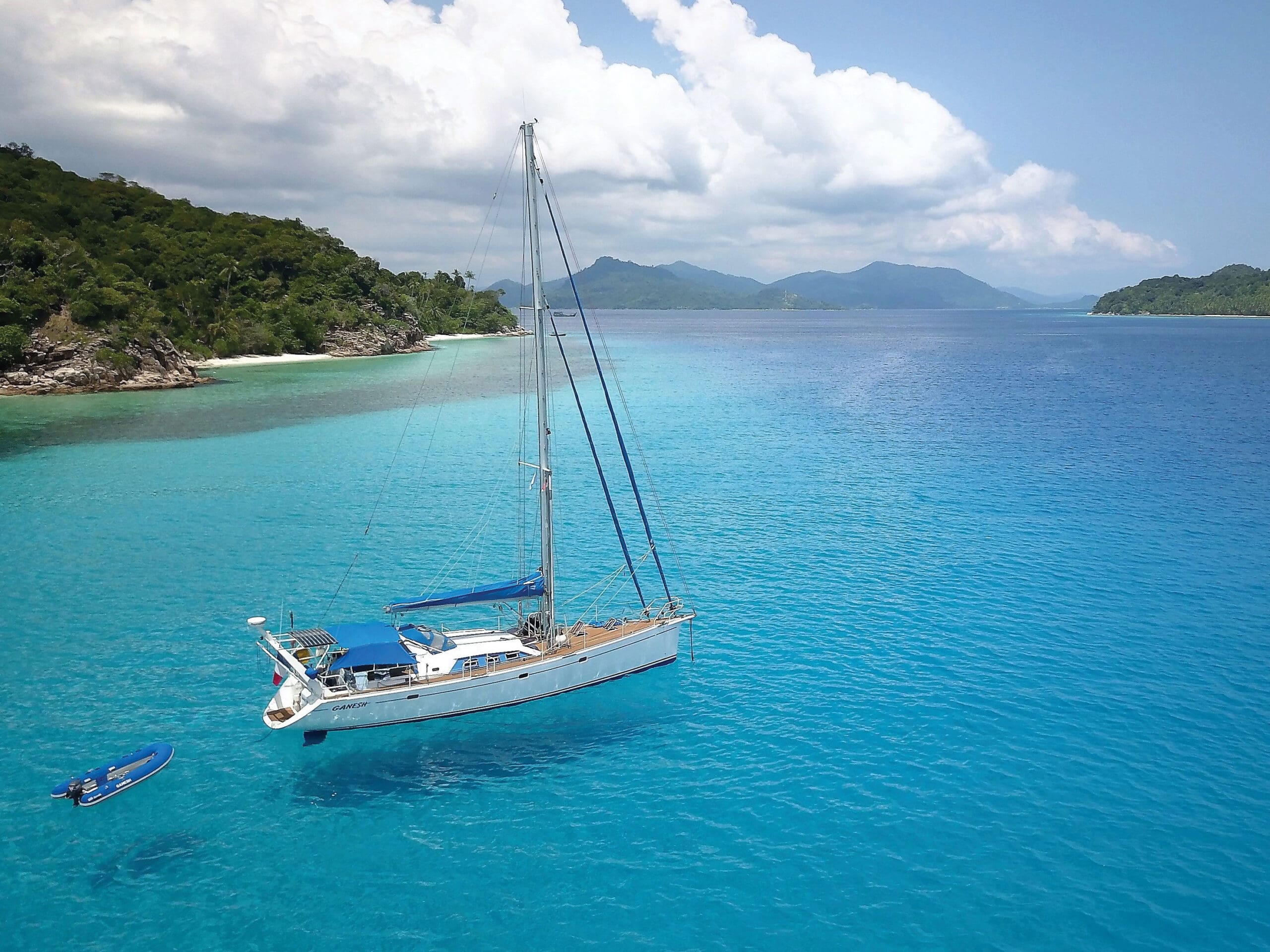
Following are the main differences between our old Garcia and our new Alliage. First comes the size. Three more feet in length makes more volume, more comfort and higher speed, but also a higher budget! Next, in terms of performance and comfort, 20 years of research and development enabled the design of better-performing hulls (hull shape, waterline length, etc.), including wider cockpits, which also provide the advantage of much less rolling in an anchorage and at sea.
All in all, we still feel happy with our 12-year-old Ganesh, even if, of course, progress and innovation are always possible.
OV:
How do you generate electricity on your boat?
C&MG:
We use 600W solar panels, which allow nearly total autonomy when we are at anchor in tropical situations, plus a 220V/5kW generator, a 5kW engine alternator, a 12V/100A Balmar alternator, a 12V/150A battery charger and a 100A charger.
We use our house battery bank to run our watermaker (100 liters per hour), which has two motors, one at 220V and the other using 12V power. We use them, of course, when we are motoring and if needed to run the watermaker with its 12V motor. You’ll notice that everything is doubled in terms of energy and watermaking. If one alternator fails, we can use the second one. Likewise, if the generator fails, we can use the motor with alternators and vice versa. In case of complete failure, the solar panels permit a great deal of autonomy.
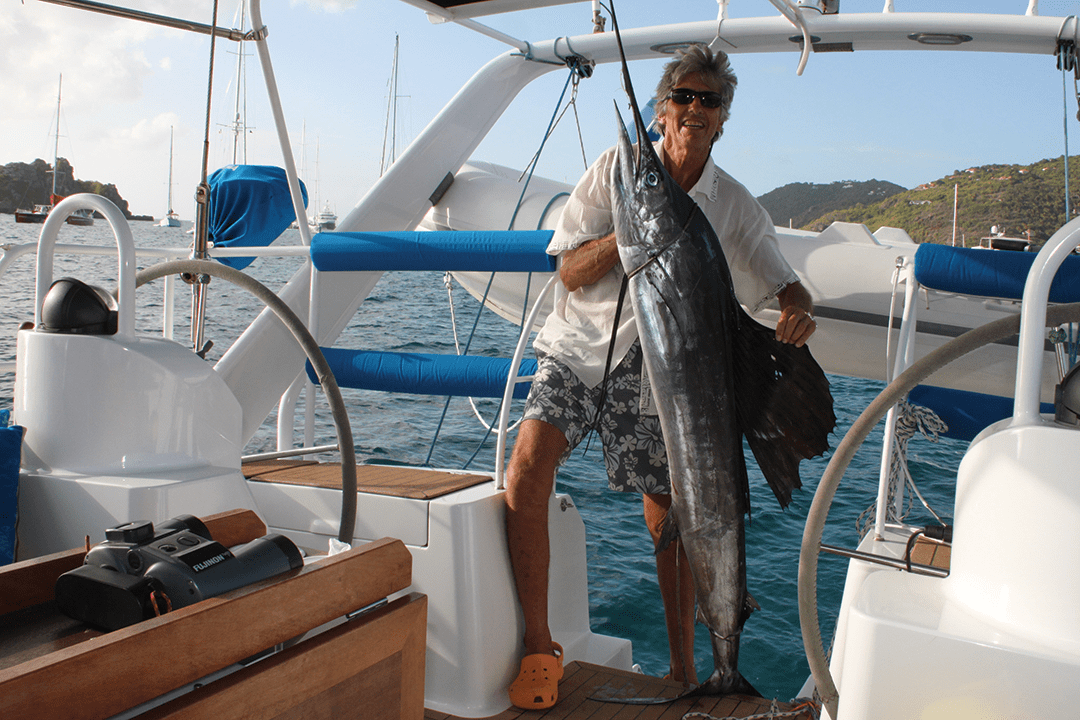
OV:
What type and capacity of batteries do you have on your boat?
C&MG:
Our house bank is a 900Ah/12V battery, and the starting battery is rated at 120Ah/12V, both of them AGM. We initially had gel batteries for the house bank, but when we had to replace them after 10 years, we could find only AGMs where we were. This works fine and allows us some autonomy.
In case of a problem—no solar panels, no motor, no generator (which has never happened in 14 years on this boat)—the house bank would allow us three to four days of charge. When we need to replace this bank, we’ll probably go to LiPo technology, which is lighter and faster to recharge and has longer life. The starter battery for the 220V generator is an AGM 120Ah bank. In case of failure, we can use the house bank with a switch to start the engine or the generator.
OV:
Do you have a WiFi network on the boat?
C&MG:
No, we currently have no WiFi network onboard.
OV:
Do you use satcom?
C&MG:
We use Iridium Go and now Starlink.
OV:
Do you have a HF SSB and VHF radios?
C&MG:
Yes, we have an Icom SSB radio, a base-mount VHF and a handheld VHF. From France to southeast Asia via Brazil, then to Panama and the Pacific, as I am a ham radio operator, we used the SSB mainly for email. We had a faster and more reliable connection than with Iridium. Iridium was here only for safety in case of telephone necessity. In Southeast Asia, we used a local SIM card or Iridium, as very few ham radio stations were available.
OV:
What type of anchor do you use?
C&MG:
We use a 35 kg Spade S160 as our main anchor with 80 meters of 12mm chain, along with 20 meters of nylon rode if necessary. We also have a second anchor, a Fortress FX55, in case of very bad weather. We also have a third anchor, a small Fortress, if we need a stern anchor.
OV:
What is your auxiliary engine?
C&MG:
The auxiliary engine is an 85hp Nanni. Nanni is a French-Italian motor supplier very involved in the yachting industry. It’s a four-cylinder Kubota engine with strong torque at low speed. At 1300 rpm, we move along at about 6 knots, and it is quite silent and nice for days with no wind.
OV:
What is the most important maintenance task you perform while voyaging?
C&MG:
I think the most important maintenance task I perform is, before voyaging, preventive maintenance. While underway, I just do a regular check and try to solve problems that may occur.
OV:
What equipment do you plan to add next to your boat?
C&MG
We plan to add some more solar panels. We now have 600W of solar power, and with a total of 1200W, we would be 100 percent autonomous. There would be no need to use the generator or the engine to run the watermaker, and the same goes for navigating with the autopilot and all the other electronic equipment. At anchor, even with clouds or rainy weather, the same. Considering the energy point of view, the engine and 220V generator would become back-ups in this context. And we have enough room on our boat to make this transition easily. We just have to do it!
OV:
What are your future voyaging plans?
C&MG:
We left France in 2011, and we are on our way back home by way of the Indian Ocean, the Red Sea and the Med for two or three years. Then we will probably sell the boat. By the way, when filling our diesel tank yesterday, I remembered that I forgot to tell you that we also customized our tanks for long passages: 750 liters of diesel in two tanks, plus 650 liters of water in two tanks. ν

